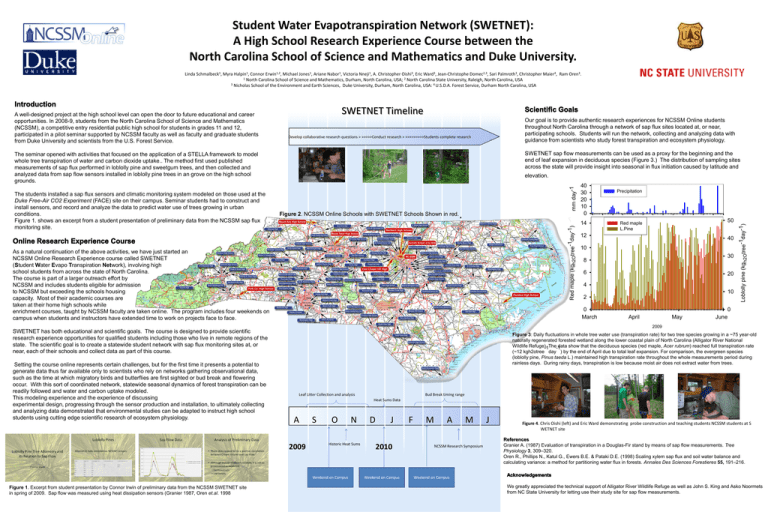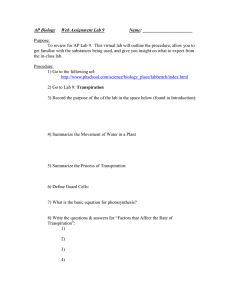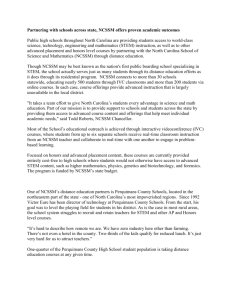SWETNET Poster
advertisement

Student Water Evapotranspiration Network (SWETNET): A High School Research Experience Course between the North Carolina School of Science and Mathematics and Duke University. Linda Schmalbeck1, Myra Halpin1, Connor Erwin1,2, Michael Jones1, Ariane Nabor1, Victoria Nneji1, A. Christopher Oishi3, Eric Ward3, Jean-Christophe Domec2,3, Sari Palmroth3, Christopher Maier4, Ram Oren3. 1 North Carolina School of Science and Mathematics, Durham, North Carolina, USA; 2 North Carolina State University, Raleigh, North Carolina, USA 3 Nicholas School of the Environment and Earth Sciences, Duke University, Durham, North Carolina, USA: 4 U.S.D.A. Forest Service, Durham North Carolina, USA SWETNET Timeline Our goal is to provide authentic research experiences for NCSSM Online students throughout North Carolina through a network of sap flux sites located at, or near, participating schools. Students will run the network, collecting and analyzing data with guidance from scientists who study forest transpiration and ecosystem physiology. Develop collaborative research questions > >>>>>Conduct research > >>>>>>>>>Students complete research SWETNET sap flow measurements can be used as a proxy for the beginning and the end of leaf expansion in deciduous species (Figure 3.) The distribution of sampling sites across the state will provide insight into seasonal in flux initiation caused by latitude and The seminar opened with activities that focused on the application of a STELLA framework to model whole tree transpiration of water and carbon dioxide uptake.. The method first used published measurements of sap flux performed in loblolly pine and sweetgum trees, and then collected and analyzed data from sap flow sensors installed in loblolly pine trees in an grove on the high school grounds. Figure 2. NCSSM Online Schools with SWETNET Schools Shown in red. mm day-1 . Red maple (kgh2Otree-1day-1) The students installed a sap flux sensors and climatic monitoring system modeled on those used at the Duke Free-Air CO2 Experiment (FACE) site on their campus. Seminar students had to construct and install sensors, and record and analyze the data to predict water use of trees growing in urban conditions. Figure 1. shows an excerpt from a student presentation of preliminary data from the NCSSM sap flux monitoring site. elevation. As a natural continuation of the above activities, we have just started an NCSSM Online Research Experience course called SWETNET (Student Water Evapo Transpiration Network), involving high school students from across the state of North Carolina. The course is part of a larger outreach effort by NCSSM and includes students eligible for admission to NCSSM but exceeding the schools housing capacity. Most of their academic courses are taken at their home high schools while enrichment courses, taught by NCSSM faculty are taken online. The program includes four weekends on campus when students and instructors have extended time to work on projects face to face. 40 30 20 10 0 14 Precipitation 50 Red maple L.Pine 12 40 10 30 8 6 20 4 10 2 0 March April May Loblolly pine (kgh2Otree-1day-1) A well-designed project at the high school level can open the door to future educational and career opportunities. In 2008-9, students from the North Carolina School of Science and Mathematics (NCSSM), a competitive entry residential public high school for students in grades 11 and 12, participated in a pilot seminar supported by NCSSM faculty as well as faculty and graduate students from Duke University and scientists from the U.S. Forest Service. 0 June 2009 SWETNET has both educational and scientific goals. The course is designed to provide scientific research experience opportunities for qualified students including those who live in remote regions of the state. The scientific goal is to create a statewide student network with sap flux monitoring sites at, or near, each of their schools and collect data as part of this course. Setting the course online represents certain challenges, but for the first time it presents a potential to generate data thus far available only to scientists who rely on networks gathering observational data, such as the time at which migratory birds and butterflies are first sighted or bud break and flowering occur. With this sort of coordinated network, statewide seasonal dynamics of forest transpiration can be readily followed and water and carbon uptake modeled. This modeling experience and the experience of discussing experimental design, progressing through the sensor production and installation, to ultimately collecting and analyzing data demonstrated that environmental studies can be adapted to instruct high school students using cutting edge scientific research of ecosystem physiology. Figure 3: Daily fluctuations in whole tree water use (transpiration rate) for two tree species growing in a ~75 year-old naturally regenerated forested wetland along the lower coastal plain of North Carolina (Alligator River National Wildlife Refuge). data show that the deciduous species (red maple, Acer rubrum) reached full transpiration rate -1The-1 (~12 kgh2otree day ) by the end of April due to total leaf expansion. For comparison, the evergreen species (loblolly pine, Pinus taeda L.) maintained high transpiration rate throughout the whole measurements period during rainless days. During rainy days, transpiration is low because moist air does not extract water from trees. Leaf Litter Collection and analysis Heat Sums Data A 2009 S O N Historic Heat Sums Weekend on Campus Figure 1. Excerpt from student presentation by Connor Irwin of preliminary data from the NCSSM SWETNET site in spring of 2009. Sap flow was measured using heat dissipation sensors (Granier 1987, Oren et.al. 1998 Bud Break timing range D J 2010 Weekend on Campus F M A M NCSSM Research Symposium J Figure 4. Chris Oishi (left) and Eric Ward demonstrating probe construction and teaching students NCSSM students at S WETNET site References Granier A. (1987) Evaluation of transpiration in a Douglas-Fir stand by means of sap flow measurements. Tree Physiology 3, 309–320. Oren R., Phillips N., Katul G., Ewers B.E. & Pataki D.E. (1998) Scaling xylem sap flux and soil water balance and calculating variance: a method for partitioning water flux in forests. Annales Des Sciences Forestieres 55, 191–216. Weekend on Campus We greatly appreciated the technical support of Alligator River Wildlife Refuge as well as John S. King and Asko Noormets from NC State University for letting use their study site for sap flow measurements.






